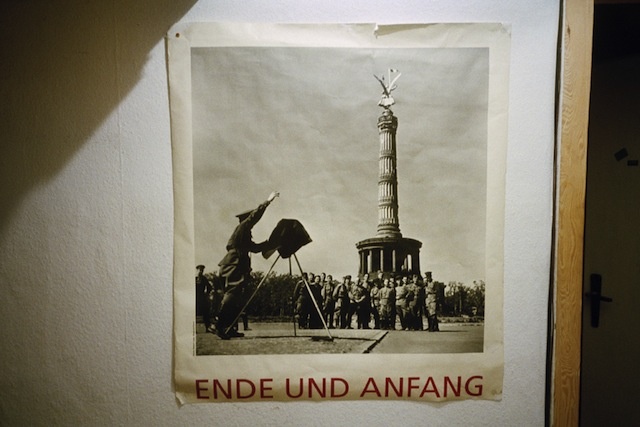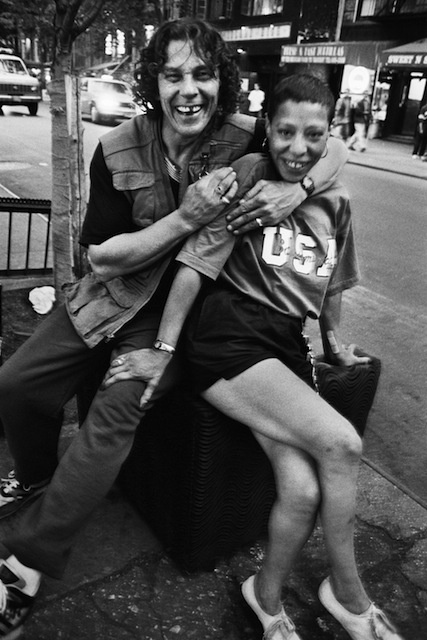Swedish photographer Jan Henrik Engström is one of the reasons contemporary Scandinavian photography is acknowledged worldwide. If you were already aware of that, you probably know him better as 'JH' and came across him some time after his widely acclaimed 2004 photo book, Trying to Dance. Since that was released, he's had praise heaped upon him from people like Robert Frank, won prizes all over the place, released a bunch more photo books, and collaborated with people like Anders Petersen and his partner, Margot Wallard.JH's forthcoming book, Ende und Anfang, is coming out this October on André Frère Éditions, and is made up of photographs he took at the end of the 20th century while traveling around Europe and the US. Two more of his books, Sketch of Paris (Aperture) and Långt Från Stockholm (Mörel Books), will also be released this year. And, as some of his work will be included in Lost Home (Super Labo) alongside nine other photographers, that brings his number of photo book releases up to 15 by the end of 2013. Which is a lot of photo book releases.With all this stuff coming out, I figured it was time to catch up for a chat. VICE: Hey, Jan. You'll soon have released a total of 15 books—why so many?
VICE: Hey, Jan. You'll soon have released a total of 15 books—why so many?
JH Engström: A book is the ultimate photographic expression. Photography in painting, sculpture, or installations lose so much, and all you get is a poor reproduction. A photography book in high-quality print does the photograph 100 percent justice. As such, the photo book is what interests me, as opposed to catalogs with photographic art. It's an important component of the expression. What can be expressed in a book is often more interesting and complex than, for example, a photographic work hanging on a wall. A good photo book also implies a dimension of forward movement. What does the title of your next book, Ende und Anfang [The End and the Beginning] refer to?
The title means what it says: the end and the beginning. It’s obviously a reference to time. Time fascinates me. A lot has happened since the photos in the book were taken, which has changed our image of the world—the terror attack on New York, for example. The title also poses an intriguing question: when does anything start or finish? Photographers often have themes for their books, but you seem to avoid that. Why?
I have themes, too. Maybe they're just not that obvious. I'm aiming for a freer approach to communicating the photographic image. I believe the recipient’s capability of interpreting and drawing emotional and intellectual conclusions is generally underestimated. I have an aversion to overemphasis and pedagogy—I’m not even sure I want the recipient to 'understand' my books. But I do want the books to touch the observer. Is it taxing to move from the intensity of photography to the quieter phase of editing? How do you handle the contrast?
It can be a strain, yeah, because of the enormous shifts in energy levels. But there’s also a hell of a buzz in the energy adjustment, so I’m not complaining. Anyway, I’m privileged to be doing what I’m doing, so I’m grateful for what I get. You have published two books—Foreign Affair and 7 Days Athens November 2011—with your partner, Margot Wallard. You're both strongly grounded in documentary photography. What's it like sharing professional and personal lives?
You have published two books—Foreign Affair and 7 Days Athens November 2011—with your partner, Margot Wallard. You're both strongly grounded in documentary photography. What's it like sharing professional and personal lives?
It works fine. And I’m not sure I even know what the word 'documentary' means. Of course, we have differences when we do projects together, but that’s how it should be. And Margot is a really blunt critic of my work. There is nothing of the admirer in her and she is ruthless in her honesty when I show her things I’ve done. That can hurt, but naturally I also appreciate it tremendously. At the moment we have separate projects that are still under wraps. Deciding on a common project is much harder than launching something on your own.You also run Atelier Smedsby, a highly regarded workshop, together. How do you choose your participants?
We try to put together a group that is as dynamic as possible. This means a large age span and that the participants are from as widely different corners of the world as possible. It’s good to have different cultural takes. The consensus vibes disappear, which is damn liberating. We balance men and women 50/50. Plus, we obviously check out their photography skills. Looking ahead, will photo books be the main way for you to express yourself, or do you think, after making A Film About/With Anders Petersen and Bertil and Maggan, that you'd like to make more documentaries?
I’d love to make more movies. Not necessarily documentaries, though. We’ll see. Which contemporary photographers do you admire?
I think I admire specific photographers or artists to a lesser extent than I used to. It’s probably age. I tend to admire people for their bodies of work, created over time. And people who aren’t tendentious. Are there any photographers you feel have been forgotten? Whose work you'd like to see a retrospective of?
There are many Swedes who haven’t had the international attention they deserve—Gerry Johansson, for example. Off the top of my head, I’d like to see everything Eva Klasson has done. As for foreign photographers, it’s a bit harder. Early photographers who fascinate me and who haven’t had much attention would be people like Claude Cahun, Stanislav Witkiewicz, Hans Bellmer, or Eli Lotar.Great. Thanks, JH!See more of JH Engström's work here.More pictures we like:Unpublished Penthouse PetsDavid Alan HarveyMoscow's Real-Life Fight Club Looks Insane
ΔΙΑΦΗΜΙΣΗ

JH Engström: A book is the ultimate photographic expression. Photography in painting, sculpture, or installations lose so much, and all you get is a poor reproduction. A photography book in high-quality print does the photograph 100 percent justice. As such, the photo book is what interests me, as opposed to catalogs with photographic art. It's an important component of the expression. What can be expressed in a book is often more interesting and complex than, for example, a photographic work hanging on a wall. A good photo book also implies a dimension of forward movement. What does the title of your next book, Ende und Anfang [The End and the Beginning] refer to?
The title means what it says: the end and the beginning. It’s obviously a reference to time. Time fascinates me. A lot has happened since the photos in the book were taken, which has changed our image of the world—the terror attack on New York, for example. The title also poses an intriguing question: when does anything start or finish? Photographers often have themes for their books, but you seem to avoid that. Why?
I have themes, too. Maybe they're just not that obvious. I'm aiming for a freer approach to communicating the photographic image. I believe the recipient’s capability of interpreting and drawing emotional and intellectual conclusions is generally underestimated. I have an aversion to overemphasis and pedagogy—I’m not even sure I want the recipient to 'understand' my books. But I do want the books to touch the observer. Is it taxing to move from the intensity of photography to the quieter phase of editing? How do you handle the contrast?
It can be a strain, yeah, because of the enormous shifts in energy levels. But there’s also a hell of a buzz in the energy adjustment, so I’m not complaining. Anyway, I’m privileged to be doing what I’m doing, so I’m grateful for what I get.
ΔΙΑΦΗΜΙΣΗ

It works fine. And I’m not sure I even know what the word 'documentary' means. Of course, we have differences when we do projects together, but that’s how it should be. And Margot is a really blunt critic of my work. There is nothing of the admirer in her and she is ruthless in her honesty when I show her things I’ve done. That can hurt, but naturally I also appreciate it tremendously. At the moment we have separate projects that are still under wraps. Deciding on a common project is much harder than launching something on your own.You also run Atelier Smedsby, a highly regarded workshop, together. How do you choose your participants?
We try to put together a group that is as dynamic as possible. This means a large age span and that the participants are from as widely different corners of the world as possible. It’s good to have different cultural takes. The consensus vibes disappear, which is damn liberating. We balance men and women 50/50. Plus, we obviously check out their photography skills. Looking ahead, will photo books be the main way for you to express yourself, or do you think, after making A Film About/With Anders Petersen and Bertil and Maggan, that you'd like to make more documentaries?
I’d love to make more movies. Not necessarily documentaries, though. We’ll see. Which contemporary photographers do you admire?
I think I admire specific photographers or artists to a lesser extent than I used to. It’s probably age. I tend to admire people for their bodies of work, created over time. And people who aren’t tendentious. Are there any photographers you feel have been forgotten? Whose work you'd like to see a retrospective of?
There are many Swedes who haven’t had the international attention they deserve—Gerry Johansson, for example. Off the top of my head, I’d like to see everything Eva Klasson has done. As for foreign photographers, it’s a bit harder. Early photographers who fascinate me and who haven’t had much attention would be people like Claude Cahun, Stanislav Witkiewicz, Hans Bellmer, or Eli Lotar.
ΔΙΑΦΗΜΙΣΗ